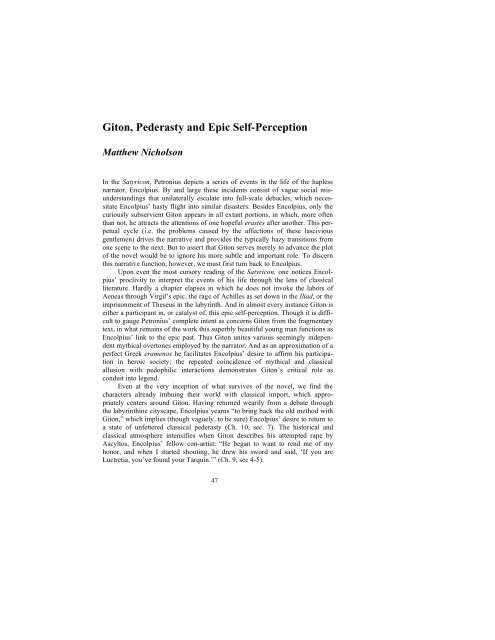Create successful ePaper yourself
Turn your PDF publications into a flip-book with our unique Google optimized e-Paper software.
Giton, Pederasty and Epic Self-Perception<br />
Matthew Nicholson<br />
In the Satyricon, Petronius depicts a series of events in the life of the hapless<br />
narrator, Encolpius. By and large these incidents consist of vague social misunderstandings<br />
that unilaterally escalate into full-scale debacles, which necessitate<br />
Encolpius’ hasty flight into similar disasters. Besides Encolpius, only the<br />
curiously subservient Giton appears in all extant portions, in which, more often<br />
than not, he attracts the attentions of one hopeful erastes after another. This perpetual<br />
cycle (i.e. the problems caused by the affections of these lascivious<br />
gentlemen) drives the narrative and provides the typically hazy transitions from<br />
one scene to the next. But to assert that Giton serves merely to advance the plot<br />
of the novel would be to ignore his more subtle and important role. To discern<br />
this narrative function, however, we must first turn back to Encolpius.<br />
Upon even the most cursory reading of the Satyricon, one notices Encolpius’<br />
proclivity to interpret the events of his life through the lens of classical<br />
literature. Hardly a chapter elapses in which he does not invoke the labors of<br />
Aeneas through Virgil’s epic, the rage of Achilles as set down in the Iliad, or the<br />
imprisonment of Theseus in the labyrinth. And in almost every instance Giton is<br />
either a participant in, or catalyst of, this epic self-perception. Though it is difficult<br />
to gauge Petronius’ complete intent as concerns Giton from the fragmentary<br />
text, in what remains of the work this superbly beautiful young man functions as<br />
Encolpius’ link to the epic past. Thus Giton unites various seemingly independent<br />
mythical overtones employed by the narrator. And as an approximation of a<br />
perfect Greek eramenos he facilitates Encolpius’ desire to affirm his participation<br />
in heroic society; the repeated coincidence of mythical and classical<br />
allusion with pedophilic interactions demonstrates Giton’s critical role as<br />
conduit into legend.<br />
Even at the very inception of what survives of the novel, we find the<br />
characters already imbuing their world with classical import, which appropriately<br />
centers around Giton. Having returned wearily from a debate through<br />
the labyrinthine cityscape, Encolpius yearns “to bring back the old method with<br />
Giton,” which implies (though vaguely, to be sure) Encolpius’ desire to return to<br />
a state of unfettered classical pederasty (Ch. 10, sec. 7). The historical and<br />
classical atmosphere intensifies when Giton describes his attempted rape by<br />
Ascyltos, Encolpius’ fellow con-artist: “He began to want to rend me of my<br />
honor, and when I started shouting, he drew his sword and said, ‘If you are<br />
Luctretia, you’ve found your Tarquin.’” (Ch. 9, sec 4-5).<br />
47

















